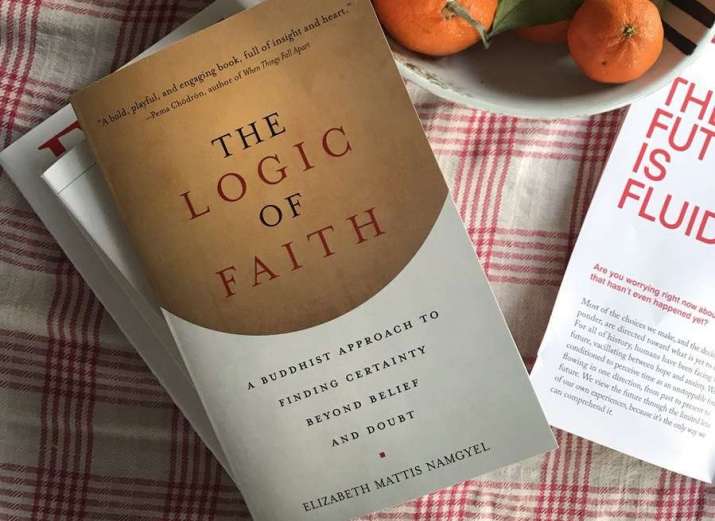
My formative years at university were spent studying the philosophy of religion. We encountered the concept of faith very early on. One of the key dichotomies set up in our beginner courses was the apparent disconnect between the requirement of faith, which one must possess in order to believe in and commit to a religious or theological tradition, and intellect, which we use to grapple with matters of spiritual belief. One of the main discussions in the philosophy of religion is whether we make a rational commitment to the uncertainty of faith, or whether the profound experience of faith is the starting point for a rational engagement with the supernatural and or revelatory.
Faith is the focus of Elizabeth Mattis Namgyel’s newest book: The Logic of Faith: A Buddhist Approach to Finding Certainty Beyond Belief and Doubt. This relatively short yet insightful work is packed with creative ways for exploring faith in a Buddhist context and, more importantly, it challenges how philosophy has traditionally framed faith and logic in a delightfully Buddhist manner.
Namgyel is a religious teacher and writer in the tradition of her teacher and husband Dzigar Kongtrul Rinpoche. Her academic background is in anthropology and Buddhist studies, but as far as I can see, her book does not approach faith from a formal philosophy of religion perspective. Instead, she stresses at multiple points that she wishes to approach faith from a playful angle, hence her use of the unconventional term “faithing” throughout: “Faithing is a playful exchange that transpires between your own discernment and the world you experience,” she writes. “But the object encountered alone is not what causes faith to arise. You have to recognize the object as something of value. Recognition, inspiration, and appreciation arise as natural qualities of your own mind. You can understand faithing as a dance between your so-called inner and outer worlds.”
Her message echoes the sentiments of the pre-schism Church Fathers, Buddhist logicians like Nagarjuna and Dignaga, and theologians of Judaism and Islam: that faith and reason are not mutually exclusive. To be sure, she reveals her hand early on, suggesting that faith, defined as the desire to find ease in a world that cannot be secured, is necessary. What is different is that we are faithing, rather than simply having faith; faith is no longer simply a corrective to reason, nor a blind belief in religious doctrine. It is something that we do, involving less thinking or juxtaposition and more being and acting.
Namgyel’s understanding of faith begins and ends with pratityasamutpada, or dependent origination. “Pratityasamutpada describes how everything we experience—both material and conscious—arises, plays out, and falls away in reliance upon an infinite web of contingent relationships.” Dependent origination leads to shunyata, interconnectedness, and this sense of total interconnectedness with the world leads, in turn, to a radically different way of experiencing faith.

“Please know that insight into interdependence lies at the very core of the Buddha’s realization and path. Such insight is interruptive to our tenacious systems of delusions. . . . I am not in total command, yet everything I do matters. I am neither big nor small,” Namgyel writes. “I am, however, part of the great nature of infinite contingency, and in the moments I embody this wisdom, I live in grace. And even in the times my habitual tendencies overwhelm me and I let the appearance of things outshine their nature, I have faith in the nature of interdependence and the path of pratityasamutpada.”
Faith is an expression of the primeval human encounter with the world. It can also be a pathway to rigid views and fanaticism, when distorted. When understood correctly, faith is an opening to revisit experience with a curious, open, and humble attitude. In this sense Namgyel is not concerned with using the traditional conceptions of faith as “apologetics” for Buddhist doctrine, which would give a far less interesting book. The closest she comes to using faith to “defend” Buddhist ideas is how she frames her understanding of reincarnation. Even here, her approach is open, free, and critically, respectfully playful and fun:
“The stronger you hold on, the more you feel burdened by stress, anxiety, and the fear of extinction and loss. But if you begin to look at reincarnation as an inquiry, it will transport you out of the paradigm of is and is not. And it will create room for something lively and intelligent to occur. When I look at reincarnation in this way, I see that it serves a powerful function in directing the way I understand and live my life. It helps me see beyond my idea of myself as a singular and separate I that will, at some unknown point, fall into extinction. And seeing beyond this brings me closer to the beauty, fullness, and mystery of life, something unrestricted by the notions of me, the extinction of me—or even the reincarnation of me. For this reason, I see no need to believe or disbelief in reincarnation.”
Ultimately, Namgyel sees faith or “faithing” as something we actively participate in. In a sense this conception of “faith” moves beyond what philosophers have traditionally defined as faith. “Both faithing and Middle Waying [also framed by Namgyel as an act rather than simply a concept] refer to a path and a way of abiding or being in life,” she writes. “The both demand openness, humility, and a fierce refusal to collapse into ordinary dualistic thinking. They are for those who understand that life is not a mystery to be solved, for those who instead have an allegiance to awe and the wisdom that thoroughly enjoys the magical expression of interdependent arising.”
Namgyel did not set out to write a philosophical treatise. She moves beyond the traditional philosophy of the religious concepts of “faith” and “logic.” And the book is thoroughly readable and digestible, without talking down to readers. It is a conversation in which Namgyel invites us to engage with ourselves, relating the teachings of Buddhism to our personal experience.
As someone who continues to be passionate about the philosophy of religion long after he can justifiably say to be active student in the academic discipline, The Logic of Faith has reignited my spark. It’s encouraged me to continue my exploration and continue to challenge myself, even after settling into, in a certain sense, the complacency of institutional belief or academic rigor. More broadly, Namgyel’s articulation of “faithing” has further implications for our everyday operating in the world: a more open-minded, embracing, and unhindered way of doing so.












